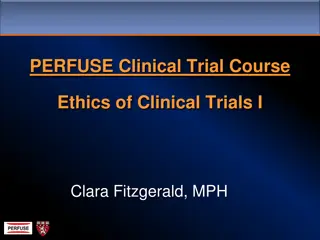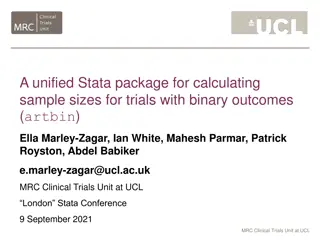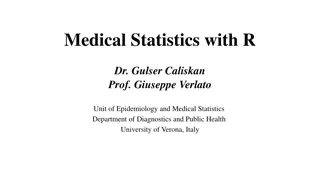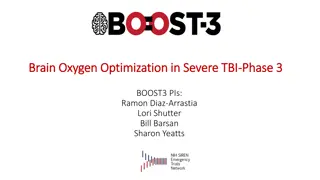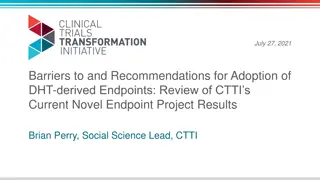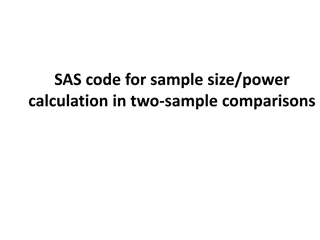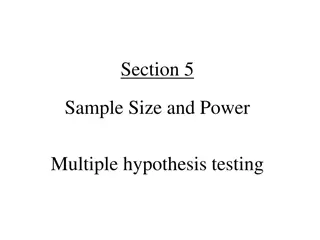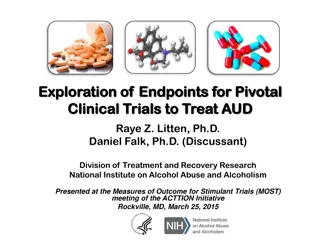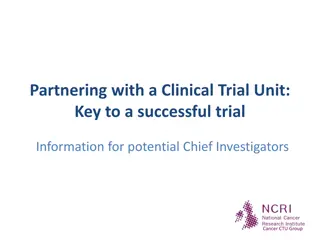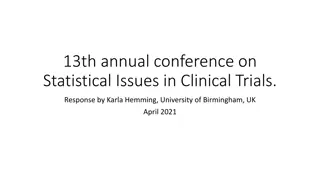Advances in Sample Size Calculations for Clinical Trials: The ART Suite
This presentation discusses the importance of sample size calculations in research studies, especially in the context of clinical trials. It covers tools like ART and Power in Stata for binary and categorical outcomes, emphasizing the need to determine the right sample size to ensure research questions are adequately answered. The talk also highlights the challenges and considerations when calculating sample sizes, such as power analysis and the impact of sample size on study outcomes.
Download Presentation

Please find below an Image/Link to download the presentation.
The content on the website is provided AS IS for your information and personal use only. It may not be sold, licensed, or shared on other websites without obtaining consent from the author. Download presentation by click this link. If you encounter any issues during the download, it is possible that the publisher has removed the file from their server.
E N D
Presentation Transcript
Advances in non-standard sample size calculations: the ART suite Ian White MRC Clinical Trials Unit at UCL Stata Biostatistics and Epidemiology Virtual Symposium 18 Feb 2021 MRC Clinical Trials Unit at UCL
Plan 1. 2. 3. 4. 5. Sample size calculation in clinical trials Stata tools: art and power Binary outcome: improving artbin Categorical outcome: developing artcat Software testing 2 MRC Clinical Trials Unit at UCL
Acknowledgements Sophie Barthel Patrick Royston Abdel Babiker Ella Marley-Zagar Tim Morris Max Parmar Babak Choodari-Oskooei all from MRC CTU 3 MRC Clinical Trials Unit at UCL
Why calculate sample size? Sample size calculations arise in planning a study We re going out to collect new data. How much data should we collect to answer our research question? especially important for funding applications Sometimes researchers can t change their sample size e.g. re-analysing existing data e.g. collecting new data but sample is fixed even so, they may need to show in advance that the analysis is likely to answer their research question ( power ) This talk is about calculations either way: power sample size All motivated by randomised trials but applicable to observational studies with little confounding 4 MRC Clinical Trials Unit at UCL
Why is it important to get it right? Increasing sample size is expensive, time-consuming, even painful don t want to do it if unnecessary Too small a sample size makes it more likely to fail to answer the research question and can cast doubt on the whole study As trials progress, it s very common to need to modify the sample size calculation due to slow recruitment new evidence about likely effect / nuisance parameters / target population Forms key part of discussions with funders 5 MRC Clinical Trials Unit at UCL
Theory of sample size calculations Statistic: e.g. risk difference Under null (NH), has mean 0 and SD ?? ???? 6 MRC Clinical Trials Unit at UCL
Theory of sample size calculations ? ???? Statistic: e.g. risk difference Under null (NH), has mean 0 and SD ?? ???? Under alternative (AH), statistic has mean ? and SD ?? so ? = ????+ ???? 1 ? but ??,?? hence formula NA for ? approximations / variants ? = ??(??+ ??) NN ? = ??(??+ ??) AA 7 MRC Clinical Trials Unit at UCL
Sample size calculations in Stata ART: Assessment of Resources for Trials Royston P, Babiker A. A menu-driven facility for complex sample size calculation in randomized controlled trials with a survival or a binary outcome. Stata J 2002;2:151 63. Barthel FM-S, Royston P, Babiker A. A menu-driven facility for complex sample size calculation in randomized controlled trials with a survival or a binary outcome: Update. Stata J 2005;5:123 9. Royston P, Barthel FM-S. Projection of power and events in clinical trials with a time-to-event outcome. Stata J 2010;10:386 94. power suite in Stata 13 (2013) 8 MRC Clinical Trials Unit at UCL
Why do we still need ART? artsurv for time-to-event outcome: allows >2 groups, staggered entry, non-constant hazard, non-proportional hazards, withdrawal from allocated treatment, treatment cross- over (switching) artbin for binary outcome: allows >2 groups, method options, non-inferiority trial 9 MRC Clinical Trials Unit at UCL
New work on artbin Providing clear description of methods used Simpler syntax More options and better syntax for non-inferiority methods Coherent output 10 MRC Clinical Trials Unit at UCL
Non-inferiority (NI) trials Estimand ? e.g. risk difference For clarity assume an unfavourable outcome The standard trial is a superiority trial we expect ? = ? where ? < 0 we aim to reject NH: ? = 0 in favour of AH: ? < 0 NI trials are used when the experimental treatment has advantages that are not captured in the primary outcome e.g. it is more acceptable to patients In a NI trial we [usually] expect ? = 0 we aim to reject NH: ? = ? in favour of AH: ? < ? where ? > 0 is a number (the NI margin ) representing an acceptably worse outcome on the experimental treatment 11 MRC Clinical Trials Unit at UCL
Superiority: artbin, pr(.4 .2) Answer 12 MRC Clinical Trials Unit at UCL
Non-inferiority: old syntax artbin, pr(.2 .4) ni(1) Answer 13 MRC Clinical Trials Unit at UCL
Non-inferiority: new syntax artbin, pr(.2 .2) margin(.2) Clear NH, AH Outcome type inferred Answer 14 MRC Clinical Trials Unit at UCL
Advantages of this NI approach clarity can infer & report whether outcome is favourable or unfavourable can design a NI trial with a non-null expected treatment effect e.g. STREAM trial in drug-resistant TB with favourable outcome: artbin, pr(.7 .75) margin(-.1) aratio(1 2) 15 MRC Clinical Trials Unit at UCL
Being methodical about calculation options Settings Options superiority non-inferiority heterogeneity trend 2 arms continuity correction >2 arms Methods Test types Unconditional Score local (NN) Conditional Score condit (N/C for NI) N/C Wald N/A Local: approximation ??:= ?? Distant: no approximation default (NA) wald (AA) NN, NA, AA: formula types. N/A: not applicable. N/C: not coded. 16 MRC Clinical Trials Unit at UCL
New program: artcat 17 MRC Clinical Trials Unit at UCL
Motivation In 2020, I was involved in designing a trial of treatments for COVID-19 that could be used in an African outpatient setting thanks to the team incl. Debbie Ford, Hanif Esmail, Di Gibb, Anna Turkova, Annabelle South We considered a 3-level ordered categorical outcome: death; in hospital; or alive and not in hospital Other COVID-19 trials have used other ordered categorical outcomes, typically with 6-8 levels We needed sample size calculations for an ordered categorical outcome, and they were not available in Stata Ideas apply beyond COVID-19 18 MRC Clinical Trials Unit at UCL
Whiteheads method Now consider an ordered categorical outcome with levels ? = 1,2,3, Analysis will be by the proportional odds model (Stata ologit) assuming a common log odds ratio ? Whitehead (1993) proposed a method based on the null variance (i.e. method NN). Allowing allocation ratio ?:1 (control:experimental) gives a total sample size ? =3 ? + 12? ??21 ? ?? where ??=????+??? ?+1 ? is the expected value of ? 2 ? 2+ ?? 3 is the overall outcome proportion at level ? 19 MRC Clinical Trials Unit at UCL
Limitations of Whiteheads method 1. It requires a common odds ratio at the design stage. But e.g. in the COVID-19 trial, we considered a 3-level outcome of death / hospitalisation / OK, and assumed a common risk ratio of 0.75 for the 2 adverse outcomes. It uses the NN method, so may be inaccurate It doesn t allow for non-inferiority trials 2. 3. 20 MRC Clinical Trials Unit at UCL
New proposal ologit method Idea: var ? = ?2/? so compute ?2 by setting ? = 1 in a data set of expected results per patient e.g. if the probabilities are and we have probability 0.5 of allocation to each arm then expected results are Now run ologiton these expected data and set ?? observed variance of ? Repeat with probs ???,??? changed to ?? to get ?? Use standard formula Extends to non-inferiority Level ? 1=death 2=hospitalisation 3=OK ??? .08 .24 .68 ??? .06 .18 .76 Outcome 1 2 3 1 2 3 Rand c c c e e e Prob .04 .12 .34 .03 .09 .38 2 equal to the 2 21 MRC Clinical Trials Unit at UCL
artcat outline of syntax Immediate command, like artbin, artsurv, power User specifies: 1. The outcome probabilities in the control arm a. directly: pc(0.08 0.24) b. or as cumulative probabilities: pc(0.08 0.32) cum 2. The probabilities in the experimental arm a. directly: pe(0.06 0.18) b. as cumulative probabilities: pe(0.06 0.24) cum c. via a common OR or RR: or(0.7) or rr(0.75) 3. Either power() or n() 4. Various options e.g. allocation ratio aratio(2 1) or for NI trial margin(1.2) Effects are expressed as odds ratios (not log odds ratios). The syntax restricts to a two-arm trial. 22 MRC Clinical Trials Unit at UCL
Lets be sure we have specified the probabilities correctly Answer 23 MRC Clinical Trials Unit at UCL
FLU-IVIG example We reproduce the sample size calculation for the FLU-IVIG trial (Davey et al. 2019). The control arm is expected to have a 1.8% probability of the worst outcome (death), a 3.6% probability of the next worst outcome (admission to an intensive care unit), and so on. The trial is designed to have 80% power if the intervention achieves an odds ratio of 1.77 for a favourable outcome. We invert this odds ratio because artcat is designed to focus on unfavourable outcomes. artcat, pc(.018 .036 .156 .141 .39) or(1/1.77) power(.8) whitehead unfavourable 24 MRC Clinical Trials Unit at UCL
Answer 25 MRC Clinical Trials Unit at UCL
FLU-IVIG example (ctd) The calculated sample size is 320 using the Whitehead method Using the new (NA) method instead gives a very similar sample size of 322 26 MRC Clinical Trials Unit at UCL
Evaluation Consider 6-level outcome like FLU-IVIG Compare methods by computing the sample size by each method Evaluate methods by fixing the sample size and computing power by each method and by simulation Simulation outline: simulate control data as specified and experimental data with assumed odds ratio test H0 using ologit + Wald test (sometimes fails due to perfect prediction) or LRT repeat 100000 times & compute power all Monte Carlo errors are about 0.1% 27 MRC Clinical Trials Unit at UCL
Comparison (6-level outcome) Sample size for 90% power, calculated from sample size formula Whitehead New NN 56 56 98 98 168 168 291 291 534 534 1090 1090 2777 2777 Odds ratio New NA 60 102 172 295 538 1094 2781 New AA 67 109 178 302 544 1101 2787 0.2 0.3 0.4 0.5 0.6 0.7 0.8 Difference between methods up to 10 Whitehead = New NN (always) Differences unimportant for moderate odds ratios (>=0.5) Differences important for extreme odds ratios (<=0.4) 28 MRC Clinical Trials Unit at UCL
Evaluation (6-level outcome) Power %, from sample size formula or simulation New NN New NA 90.1 88.1 90.1 88.9 90.1 89.4 90.0 89.6 90.0 89.8 90.0 89.9 90.0 90.0 Sample size by NN 56 98 168 291 534 1090 2777 Odds Ratio New AA 84.5 86.9 88.3 89.0 89.5 89.7 89.9 Simulation 88.4 89.2 89.5 89.6 89.7 90.1 90.1 0.2 0.3 0.4 0.5 0.6 0.7 0.8 All methods are accurate for moderate odds ratios (>=0.5) New NA performs best for extreme odds ratios (<=0.4). NN (Whitehead) method is slightly anti-conservative. 29 MRC Clinical Trials Unit at UCL
Software testing We have started a programme of testing our unit s software This program may be used to design randomised trials so it is crucial to get it right We ve decided to report how we ve tested so 30 MRC Clinical Trials Unit at UCL
Software testing for artbin and artcat Compared with published results artbin: publications e.g. Pocock 2003 artcat: Whitehead 1993 Compared with other software artbin: Sealed Envelope; Stata ssi; niss; sampsi; power artcat: R package dani (Quartagno 2019) Checked error messages in a number of impossible cases, for example negative odds ratio Checked every combination of calculation options Run simulations 31 MRC Clinical Trials Unit at UCL
Discussion ART suite provides user-friendly functionality that s not available in power artcat paper is submitted to SJ & program available on github; artbin paper & program in preparation Data sets of expected outcomes can be used more broadly for sample size calculations (e.g. covariate adjustment) Should we / how should we report software testing? 32 MRC Clinical Trials Unit at UCL
Extra slides 33 MRC Clinical Trials Unit at UCL
Comparison 2: binary outcome Control probability 0.2, power 0.9 Sample size calculated by artbin local distant New NN New NA New AA 197 192 150 290 285 249 439 436 403 699 694 666 1198 1198 1168 2322 2322 2294 5664 5664 5638 OR artcat power 0.2 0.3 0.4 0.5 0.6 0.7 0.8 194 286 436 696 1194 2318 5660 180 274 425 686 1186 2311 5654 230 314 460 717 1214 2336 5677 Again all methods agree for moderate odds ratios power and artbin agree for all odds ratios but artcat disagrees for extreme odds ratios 34 MRC Clinical Trials Unit at UCL
Evaluation 2: binary outcome Power %, from sample size formula or simulation Odds Ratio Sample size Simulation Wald 91.8 91.0 90.7 90.4 90.3 90.2 90.0 artbin local 90.1 90.1 90.0 90.0 90.0 90.0 90.0 artcat NA 92.2 91.5 90.9 90.5 90.3 90.1 90.1 dist. 90.7 90.5 90.3 90.2 90.1 90.1 90.0 NN 96.1 93.8 92.3 91.3 90.7 90.3 90.1 AA 85.1 87.6 88.7 89.3 89.6 89.8 89.9 LRT 92.9 91.7 91.1 90.5 90.3 90.2 90.0 0.2 0.3 0.4 0.5 0.6 0.7 0.8 197 290 439 699 1198 2322 5664 All methods remain accurate for moderate odds ratios For extreme odds ratios, new NA performs best of the artcat methods better than artbin / power? 35 MRC Clinical Trials Unit at UCL





